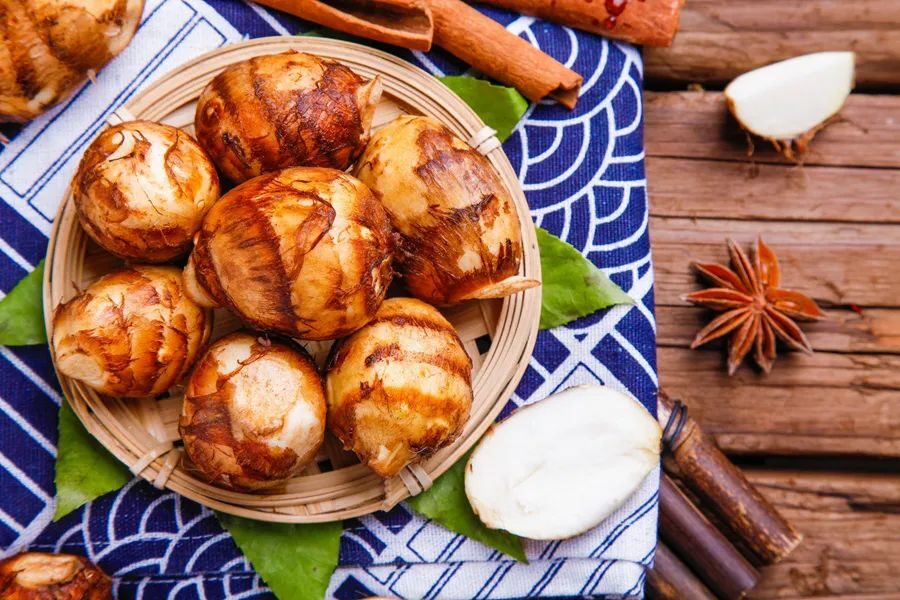
Nourishing in Late Autumn: 10 Common and Gentle Ingredients
In Traditional Chinese Medicine (TCM), autumn corresponds to the element of Metal, the Lung organ, and the color white. The Metal element is associated with strength, coolness, and the cold, drying nature of autumn. Therefore, in autumn dietary therapy, foods should be mildly pungent, slightly sour, and help nourish Yin while moistening dryness.
1. Lily Bulb
Nature: Slightly cold
Flavor: Sweet
Lily bulbs are harvested around mid-summer and are ideal for consumption in autumn. They help nourish Yin, moisten dryness, replenish vital essence and blood, and calm the mind.
Whether steamed, boiled, stir-fried, or stewed, their benefits remain consistent.

After spending the entire summer submerged in muddy ponds, lotus roots reach maturity in autumn, making them ideal for consumption.
However, their effects differ depending on whether they are eaten raw or cooked.
Raw Lotus Root: Sweet and cool in nature, it is excellent for clearing heat and moistening dryness. Freshly pressed lotus root juice is beneficial for treating conditions like coughing up blood, blood in the stool, urine, or nosebleeds.
Cooked Lotus Root: Sweet and warm in nature, it helps to darken hair and improve skin complexion. However, due to its cold nature, raw lotus root is not suitable for individuals with cold digestive systems or loose stools.

3. Celery
Nature: Sweet, cool
Flavor: Sweet
Celery has a cooling effect on the body and helps clear the stomach, remove excess heat, and dispel wind. It is also beneficial for calming the liver, reducing hypertension, and lowering blood pressure.
Celery can be finely chopped for dumpling fillings, stir-fried, or eaten in salads. Those who prefer lighter flavors can blanch it in hot water for a cold salad, or juice it for a refreshing drink.
However, those with weak digestion should eat celery sparingly.

White radish has the effect of clearing the lungs and stopping coughing. Eating it raw can relieve bloating and promote intestinal movement, making it suitable for consumption in late autumn.
If the radish skin is opaque and the flesh is spicy, it should be cooked. If the skin is translucent and the flesh is sweet rather than spicy, it can be eaten raw.

5. Chinese Yam
Nature: Neutral
Flavor: Sweet
Chinese yam is not only a common vegetable on the dining table but also a frequently used herb in TCM. Supplement selling in the pharmacy for menopausal symptoms such as hot flushes and night sweat.
According to the “Compendium of Materia Medica,” Chinese yam strengthens muscles and bones, improves memory, benefits kidney Qi, strengthens the spleen and stomach, and stops diarrhea. It is rich in nutrients and has a delicate texture, making it a versatile ingredient for both nutrition and therapy. Chinese yam promises anti-diabetic, anti-oxidative, anti-inflammatory, immunomodulatory, anti-hyperlipidemic, anti-hypertensive, anti-cancer, and combination treatment applications, both as a functional food and as medicine.

6. Taro
Nature: Neutral
Flavor: Sweet, slightly spicy
Taro has the properties of strengthening the spleen and nourishing the body, as well as dissolving lumps and detoxifying.
When used to make taro cakes, its fine texture and sweet flavor make it a perfect dish for both young and old.

7. Sweet Potato
Nature: Neutral
Flavor: Sweet
Sweet potato nourishes the middle burner (digestive organs), harmonizes the blood, and generates body fluids. It also helps regulate the intestines and stomach.
Sweet potato porridge made with glutinous rice is beneficial for nourishing the spleen, stomach, and lungs, promoting digestion, and easing constipation. It can also help lower cholesterol and reduce subcutaneous fat, contributing to longevity.

8. Okra
Nature: Cold
Flavor: Bland
Okra benefits the kidneys, throat, and urinary system, and it helps regulate menstruation. It also lowers blood sugar, protects the intestines, relieves fatigue, and enhances immunity. For these reasons, it is known as the “green ginseng.”
If symptoms of dryness such as a dry mouth, throat, burning urine, or hard stools occur in autumn, especially for those with diabetes, okra can be particularly beneficial.

9. Arrowhead (Sagittaria)
Nature: Slightly cold
Flavor: Sweet, slightly bitter
Arrowhead, also known as white water chestnut, has been used as both a food and a medicine for a long time. It clears the lungs, stops coughing, relieves urinary disorders, and detoxifies the body.
If you experience symptoms like dry throat, cough, burning urination, or excessive internal heat, arrowhead can help.

10. Chestnut
Nature: Warm
Flavor: Sweet

This season, chestnuts can be boiled, steamed, or stir-fried with sugar. They can also be braised with chicken, duck, or pork. However, individuals prone to acid reflux or belching should consume them in moderation.
These ten ingredients are mild, nourishing options for late autumn, helping to balance the body’s needs during the seasonal transition.
